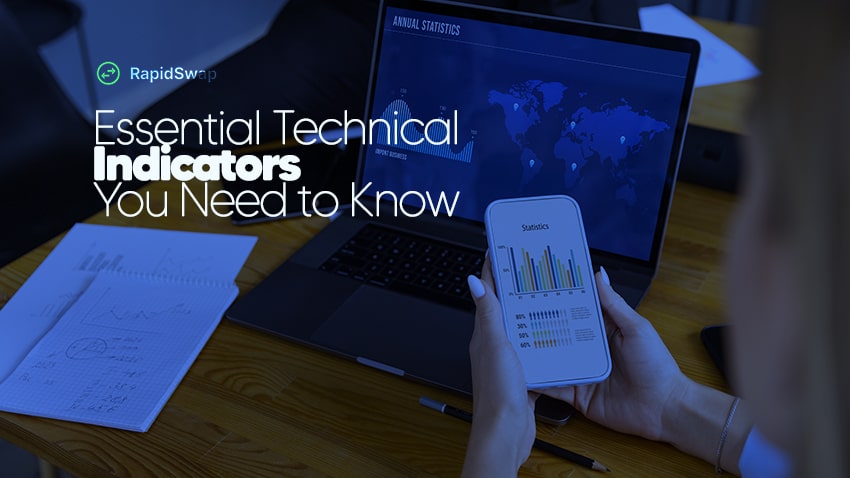Embarking on the journey of cryptocurrency trading can be a daunting task. From understanding trading platforms to navigating fees, and choosing your preferred trading pairs, the path to becoming a proficient trader is filled with challenges. Among the most critical skills you’ll need to develop is the ability to read charts and perform technical analysis. Central to this skill set are technical indicators, which serve as invaluable tools for predicting market trends and making informed trading decisions.
Understanding the Role of Technical Indicators in Crypto Trading
Technical indicators are mathematical calculations based on the price, volume, or open interest of a cryptocurrency. These indicators provide insights into the market’s current state and can help predict future price movements. While modern trading platforms automatically calculate these indicators, understanding how they work and when to use them is crucial for effective trading.
Essential Technical Indicators for Crypto Trading
To help you navigate the world of crypto trading, here’s a comprehensive guide to some of the most important technical indicators you should know about:
1. Moving Averages (MA)
Moving averages are among the most commonly used indicators in crypto trading. They smooth out price data to create a single flowing line that traders use to identify the direction of the current trend. There are two main types:
- Simple Moving Average (SMA): This is the average price of a cryptocurrency over a specific number of days. It’s calculated by adding up the closing prices over a given period and dividing by the number of periods. The SMA helps identify the overall direction of the market trend.
- Exponential Moving Average (EMA): Unlike the SMA, the EMA gives more weight to recent prices, making it more responsive to new information. This is particularly useful for spotting trend reversals earlier than the SMA might.
2. Relative Strength Index (RSI)
The RSI is a momentum oscillator that measures the speed and change of price movements. It ranges from 0 to 100 and is used to identify overbought or oversold conditions in a market:
- Overbought: An RSI above 70 suggests that the asset may be overbought and could be due for a correction.
- Oversold: An RSI below 30 indicates that the asset may be oversold and could be due for a bounce.
The RSI is particularly useful for spotting potential trend reversals and timing entry and exit points.
3. Moving Average Convergence Divergence (MACD)
The MACD is a trend-following momentum indicator that shows the relationship between two moving averages of a cryptocurrency’s price. It consists of two lines:
- MACD Line: Calculated by subtracting the 26-day EMA from the 12-day EMA.
- Signal Line: A 9-day EMA of the MACD line.
When the MACD crosses above the Signal Line, it’s often a bullish signal, indicating that it may be a good time to buy. Conversely, when it crosses below, it may be a bearish signal, suggesting it might be time to sell.
4. Bollinger Bands
Bollinger Bands consist of three lines: a middle band (SMA) and an upper and lower band that are typically two standard deviations away from the middle band. These bands expand and contract based on market volatility.
- Overbought: If the price moves to the upper band, the asset might be overbought.
- Oversold: If the price moves to the lower band, the asset might be oversold.
Bollinger Bands are particularly useful for identifying periods of high or low volatility and potential breakouts.
5. Volume Indicators
Volume indicators measure the amount of a cryptocurrency that has been traded over a specific period. They are crucial for confirming trends and identifying potential reversals.
- On-Balance Volume (OBV): This indicator combines price and volume in a cumulative total, helping to confirm price trends. If the price and OBV are both rising, it confirms an upward trend.
- Volume Weighted Average Price (VWAP): VWAP is used to measure the average price a cryptocurrency has traded at throughout the day, based on both volume and price. It’s particularly useful for day traders to ensure they are buying or selling at a good price.
Choosing the Right Indicators
With a multitude of technical indicators available, it can be overwhelming to decide which ones to use. The key is to understand that no single indicator is foolproof. Instead, successful traders often use a combination of indicators to get a more comprehensive view of the market.
- For Trend Identification: Moving Averages, MACD
- For Momentum: RSI, Stochastic Oscillator
- For Volatility: Bollinger Bands, ATR (Average True Range)
- For Volume: OBV, VWAP
Practical Application: Developing Your Strategy
As you gain experience in crypto trading, you’ll start to develop your own strategies that incorporate these indicators. It’s important to back-test your strategies using historical data to see how they would have performed in different market conditions. Additionally, practice using these indicators in a demo account before risking real capital.
Mastering the Tools of the Trade
Mastering technical indicators is a critical step on your journey to becoming a successful crypto trader. By understanding and applying these tools effectively, you can enhance your ability to predict market movements and make informed trading decisions. Remember, while technical indicators can provide valuable insights, they should be used in conjunction with other analysis methods, such as fundamental analysis and market sentiment, to create a well-rounded trading strategy.

